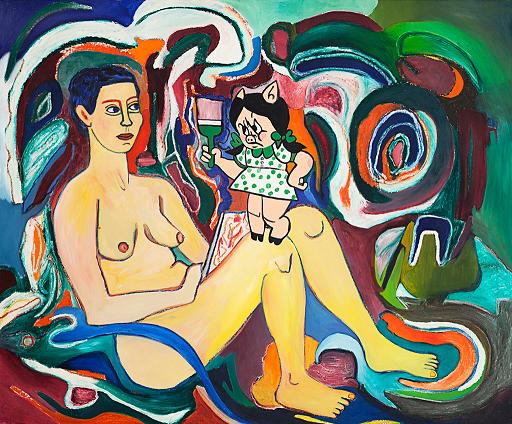
Most paintings, the instant you see them, they become familiar and then it's too late.- William Gaddis, The Recognitions
Life is a series of random events. We are in different rooms, with different people, at different times…in art, this is called having different "styles." - Dr. Hope Ardizonne, Anatomy of Art's Murder
Do you see how black the sky is? I wrote it that way. - Bret Easton Ellis, Lunar Park
To be Modern was, sooner or later, to become kitsch -- that is, familiar, a cliché, an agreed-upon collective meaning. Clement Greenberg despised kitsch, yet all the most avant-garde of movements, from the Impressionists to the Pop Artists, eventually ended up, to some degree, kitsch decorations. To be "Post-Modern," especially in the 1980s, was a high-wire act, walking a tightrope between aesthetic cynicism and irony; dabbling in kitsch, was, out of necessity, a net.
Susan Bee is a painter who, though working in a period of appropriation (à la Mike Bidlo or Cindy Sherman), managed to navigate a course of painterly activity that circumnavigated the knowing irony of most '80s painting and instead created a distinctly personal idiom in her work, through references to painters including Andrei Rublev, Georges Rouault, Vincent van Gogh, and Edvard Munch, as well as filmmakers such as Otto Preminger and Billy Wilder. A return to kitsch is an attempt at sincerity, at referring to something, once genuine, which contemporary society or culture lacks. Sincerity is a critique of the inauthentic.
Black-and-white film stills are the pictorial basis of the majority of Bee's pictures; the high-key colors, energetic patterns, and fluid painterly drips and pours render these works both visually and psychologically complex. In the works, figures move about, interacting in mise-en-scènes reminiscent of Preminger's Laura, the action happening in the complex space she frames in the painting. There is a tension in the way the abstraction plays against the figuration, which was the hallmark of film noir; Bee replaces the shadow play of the noir interior with tumultuous or rhythmic patterning.
Bee says about these works, "I have become very taken by the idea of theatricality and artifice [in my painting]. I am creating these paintings as spaces for a drama to take place. The figures are actors and actresses in a stage that I am setting up for them to play out their roles. The film stills I'm referencing are dramatic...I remain intrigued by the dangerous women and the desolate men in the film noirs...I emphasize the dynamic between the figures whether they are pressing against a windowpane or pressing up against each other."
In paintings such as Pickpocket (2013) [not in exhibition], the windowpane doubles as a set for the action and a nod toward Piet Mondrian. The window screen or grate that the woman presses her face to is like the barrier in a confessional. She can hear, smell, and -- where their hands touch -- feel the male protagonist on the other side, but, even though the screen has large openings, they both have their eyes closed and, thus, cannot see each other. The barrier between the characters is psychological: with eyes wide shut, they are their own blinds.
In Hands Up (1983), a couple laughs over a cocktail while a Pollock-like skein of paint swirls around them. Separated by a black line, a woman with a gun is either lurking stage left or outside a door, outside their space. Once again, one sees the influence of the film noir sources Bee uses. In the film Laura, we are introduced to a world of glass (bottles, glasses, the clockface), of fragile and precious objects on display, in a closed world (Waldo's apartment) within another closed world (Manhattan). Everything is suspended, and there is a sense of waiting, of time arrested. Since Laura is already dead, there is no future indicated, and the narrative will be a return to the past.

In Hands Up, the return to the past is noted by the appropriation of Pollock's signature style, though in transforming his abstraction into a theatrical décor, Bee also subverts the modernist ideal of the concrete gesture in favor of narration and psychological depth. In Portrait of the Artist as a Young Pig (1983) Bee uses Petunia Pig as a stand-in for the painter, layering the illustrative Petunia over an expressionist odalisque. It is of note that Bee's painting pre-dates the 1988 film Who Framed Roger Rabbit, the neo-noir comedy that mixed live action with animation to great effect.
Susan Bee's characters may be trapped in tight situations and dark spaces, but we get the sense that everything will turn out okay in the end. They are "doomed to win," or, to paraphrase Jessica Rabbit, "they are just drawn that way." - Bradley Rubenstein
The A.I.R. Gallery is at 111 Front Street, #228, Brooklyn, New York 11201.
